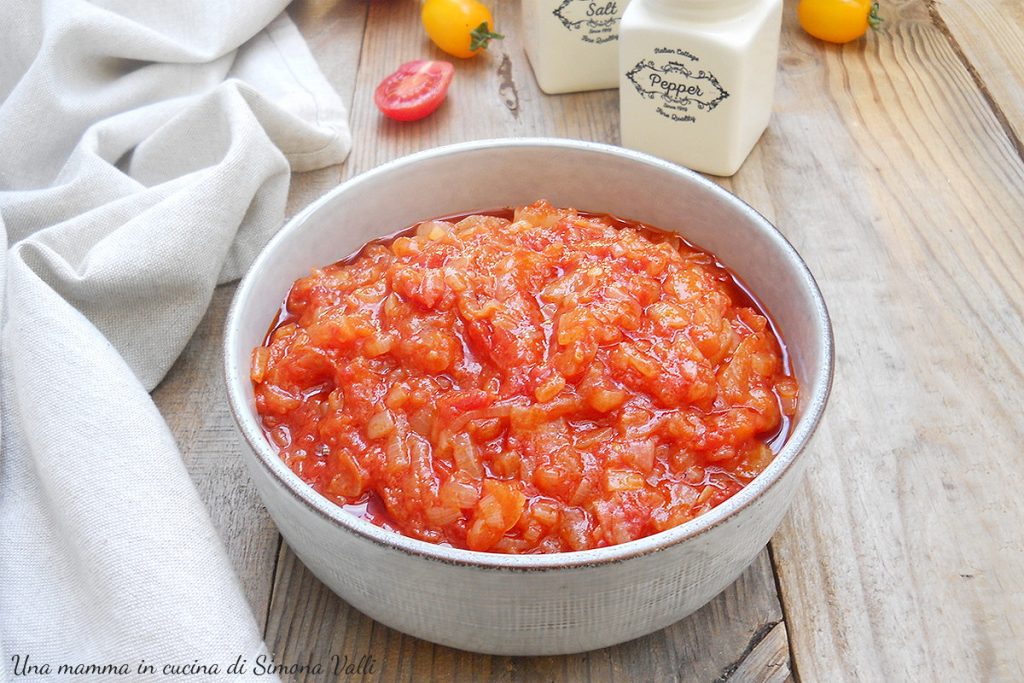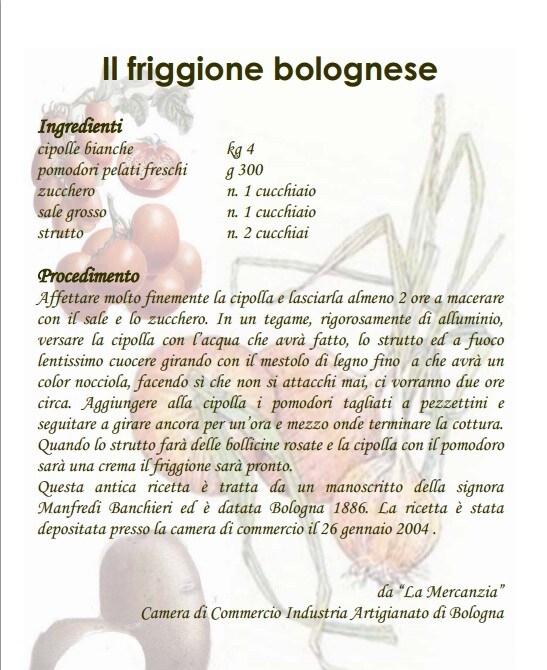The Bolognese Friggione (“frizan” in dialect) was a humble dish of peasant origin typical of the Bolognese countryside and surrounding areas. The original recipe was attributed to Maria Manfredi Baschieri, who noted it in a manuscript from 1886, and it was later deposited at the Chamber of Commerce of Bologna.
The ingredients to prepare this wonderful traditional Bolognese dish are essentially two: white onions and fresh tomatoes. However, to achieve a good friggione, the recipe alone is not enough; you need the experience of the “zdora” (the lady of the house who cooked for the whole family), who, with patience, would first marinate and then slowly cook one of the tastiest and most flavorful sauces in our cuisine.
Friggione, like many other Bolognese dishes (lasagne, tortellini, crescentine, zuppa inglese) is part of my gastronomic culture and that of my family.
When I was a girl, my mom often prepared it, and I, unable to resist its aroma, would dip bread into the pan even before it was ready. She always made it according to the traditional recipe, although sometimes she would add a bell pepper, while my grandfather used it as a base to which he added a potato, an eggplant, and some leftover grilled meat from the day before, usually sausage and ribs; he called it Fricandò.
As you might have guessed, friggione is an onion and tomato-based sauce served as a side dish with meat dishes or as an appetizer with crescentine or bread crostini.
It is perfect for dressing pasta and is excellent hot, cold, or at room temperature.
The original recipe calls for the use of lard, nowadays almost always replaced by extra virgin olive oil, white onions, and fresh or canned tomatoes. My grandmother used canned tomatoes, which she prepared every year along with tomato sauce and jams. I have kept the tradition, cutting the canned tomatoes into small pieces and adding a tablespoon of triple concentrate to give a more pronounced color and a more intense flavor.
Today I am sharing the family recipe with you, along with the deposited version.
Below you will find some of my family’s recipes:

- Difficulty: Very Easy
- Cost: Economical
- Preparation time: 2 Hours
- Portions: 8 People
- Cooking methods: Electric Oven
- Cuisine: Italian
- Seasonality: All Seasons
- Energy 106.42 (Kcal)
- Carbohydrates 11.44 (g) of which sugars 5.91 (g)
- Proteins 1.47 (g)
- Fat 6.82 (g) of which saturated 1.14 (g)of which unsaturated 0.77 (g)
- Fibers 2.42 (g)
- Sodium 249.60 (mg)
Indicative values for a portion of 100 g processed in an automated way starting from the nutritional information available on the CREA* and FoodData Central** databases. It is not food and / or nutritional advice.
* CREATES Food and Nutrition Research Center: https://www.crea.gov.it/alimenti-e-nutrizione https://www.alimentinutrizione.it ** U.S. Department of Agriculture, Agricultural Research Service. FoodData Central, 2019. https://fdc.nal.usda.gov
Ingredients
- 2.2 lbs white onions (net of waste)
- 14 oz canned tomatoes (with preserving liquid, I use 14 oz cans)
- 1 tablespoon triple tomato concentrate
- 1 tablespoon sugar
- 1 tablespoon salt
- 4 tablespoons extra virgin olive oil
Tools
- 1 Cutting board
- 1 Pan large with lid
- 1 Bowl
Procedure
Friggione is an onion and tomato sauce that melts in your mouth; it is important to follow the resting and cooking times to achieve a perfect sauce.
Peel the onions, cut them in half, and then into thin slices.
Place them in the bowl, add a tablespoon of sugar and a level tablespoon of salt, mix well, cover, and let them rest for 2 hours.
Pour the onions with the liquid formed during the rest into a large pan, add the oil, turn on the stove, and cook on low heat until they become shiny and transparent. Stir often to prevent them from sticking to the bottom of the pan.
Add the canned tomatoes cut into not too large pieces with their preserving liquid and the triple concentrate, stir, and cook on low heat for about two hours. Stir frequently.
Usually, it is not necessary to add water; the liquid released by the onions during the rest is sufficient. If needed, add a few tablespoons of water. Taste and adjust the salt.
The friggione is ready when the onion melts in your mouth and there is no trace of liquid left.
It is served as a side dish with meat dishes or as an appetizer with crescentine or bread crostini.
It is perfect for dressing pasta and is excellent hot, cold, or at room temperature.
The original recipe was attributed to Maria Manfredi Baschieri, who noted it in a manuscript from 1886, and it was later deposited at the Chamber of Commerce of Bologna.

Advice
Storage
The friggione keeps in the refrigerator for 4/5 days.
***********************
For advice on making recipes, contact me on FACEBOOK and if you like, follow me on INSTAGRAM
Send me your photos, I will be happy to publish them on my social networks

